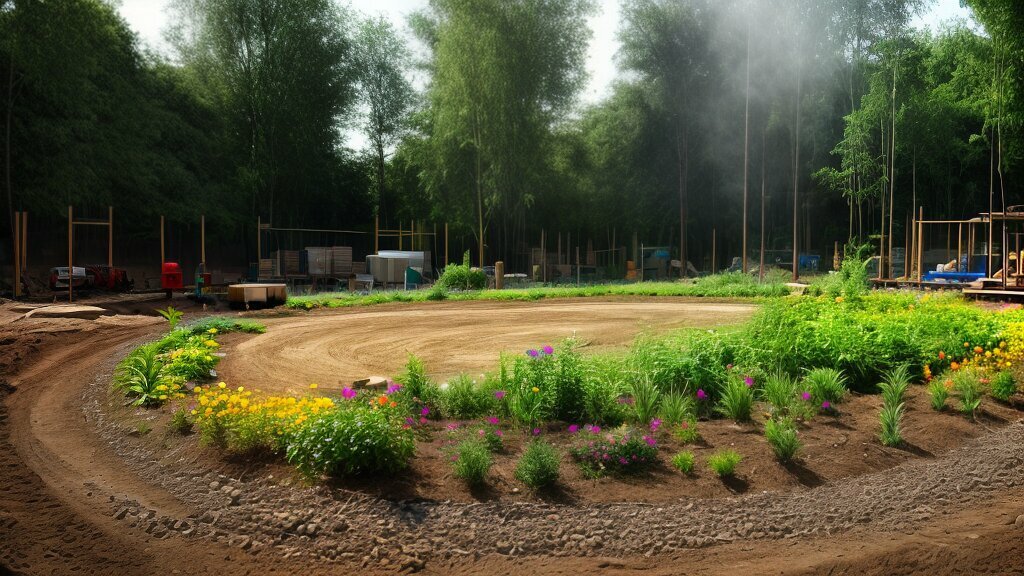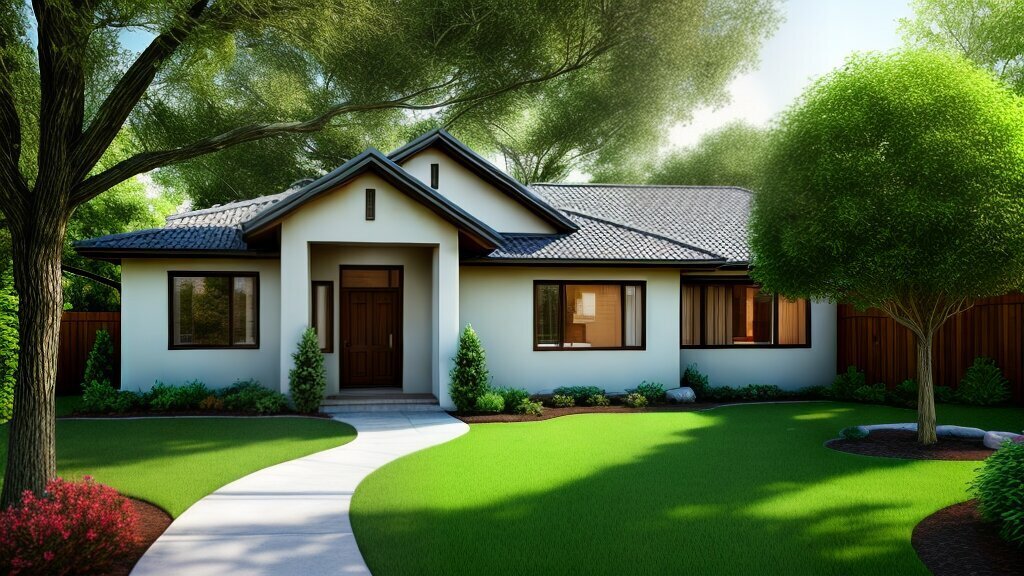Sustainable Construction in Developing Countries: Challenges and Opportunities
Welcome to our article on sustainable construction in developing countries. The construction industry has a significant impact on the environment, and as developing countries continue to experience rapid urbanization, sustainable construction practices are becoming increasingly important. However, implementing sustainable infrastructure development strategies comes with its own set of challenges. In this article, we will explore the challenges and opportunities of sustainable construction in developing countries, including the importance of green building practices, low-carbon construction methods, and the role of government and policies. Read on to educate yourself about Sustainable Development in Developing Countries
Sustainable Construction in Developing Countries Key Takeaways:
- The construction industry has a significant impact on the environment.
- Sustainable construction practices are becoming increasingly important in developing countries.
- Implementing sustainable infrastructure development strategies comes with its own set of challenges.
- We will explore the challenges and opportunities of sustainable construction in developing countries in this article.
Green Building Practices in Developing Countries
Green building practices are becoming increasingly important in developing countries, where rapid urbanization and economic growth are driving an increased demand for infrastructure. The use of eco-friendly construction techniques and renewable materials can significantly reduce the environmental impact of construction projects while promoting sustainable development.
One key consideration in green building practices is the use of locally sourced materials and resources. This reduces transportation costs and promotes local economies, while also minimizing the carbon footprint of construction projects. Additionally, the use of recycled materials and waste reduction strategies can further reduce the environmental impact of construction activities.
An important component of green building practices is energy efficiency. Buildings account for a significant portion of global energy consumption, and the use of energy-efficient building design and the integration of renewable energy sources can help reduce this impact. This can be achieved through the use of technologies such as solar panels, wind turbines, and energy-efficient lighting and heating systems.

Adopting sustainable infrastructure development strategies can also have significant social and economic benefits. Green buildings are often more comfortable and healthier to live or work in and can lead to improved productivity and well-being. Additionally, sustainable construction projects can create job opportunities and promote local economic development.
Overall, green building practices are essential in promoting sustainable development in developing countries. By using locally sourced materials, promoting energy efficiency, and adopting sustainable infrastructure development strategies, construction projects can reduce their environmental impact while creating social and economic benefits for local communities.
Low-Carbon Construction Methods
With the urgent need to mitigate climate change, it is imperative to adopt low-carbon construction methods in developing countries. These practices have the potential to reduce the carbon footprint associated with construction and can also promote a more sustainable built environment.
An effective low-carbon construction method is the use of energy-efficient building design. This strategy involves the integration of passive design techniques that reduce the need for active heating and cooling systems. For example, designing buildings with ample natural daylight and ventilation can reduce energy consumption while enhancing indoor comfort. Additionally, the use of thermal insulation and high-performance glazing can also minimize heat loss, resulting in energy savings.
Renewable energy sources can also be integrated into construction projects to reduce carbon emissions. Solar panels, for instance, can be installed on rooftops to generate electricity for lighting and electrical appliances. Similarly, wind turbines can be used to generate power in areas with high wind speeds. The use of biogas digesters can also be explored to convert organic waste into clean energy, providing an alternative to traditional fossil fuels.
| Advantages of Low-Carbon Construction | Challenges in Implementing Low-Carbon Construction |
|---|---|
|
|
Despite the numerous benefits of low-carbon construction, implementing such practices in developing countries can be challenging. These challenges include a lack of awareness and technical expertise, insufficient funding and resources, resistance to change from traditional construction practices, and policy and regulatory barriers.
Nonetheless, with increased advocacy and support from governments and stakeholders, low-carbon construction methods can be successfully implemented, contributing to a more sustainable future for developing countries.

Challenges in Implementing Sustainable Construction in Developing Countries
Sustainable construction practices can face several challenges in developing countries. The lack of resources, limited availability of eco-friendly materials, and financial constraints are some of the most significant issues. Additionally, a lack of awareness and technical expertise can also hinder the implementation of sustainable construction practices.
Many developing countries face budgetary restrictions that limit them from investing in sustainable construction projects. Moreover, the high cost of eco-friendly materials and technologies is an obstacle to the adoption of sustainable infrastructure development strategies. This situation is further complicated by the lack of sufficient knowledge and expertise among architects, engineers, and contractors.
There is a need for greater awareness and education on sustainable construction practices, as well as training programs for professionals in the field. Governments, industry stakeholders, and financial institutions can play a vital role in promoting sustainable construction practices, providing financing, and offering technical support.
Despite the challenges, there are opportunities to overcome these obstacles through innovation and collaboration. For example, sustainable construction techniques can be integrated into existing projects, and partnerships can be formed to share knowledge and resources. By leveraging these opportunities and overcoming the challenges, sustainable construction practices can become a mainstream approach in developing countries, improving social and environmental sustainability.
Sustainable Construction Projects in Developing Countries
Real-life examples of sustainable construction projects in developing countries showcase the potential for positive change and the impact of sustainable infrastructure development strategies. These projects contribute to both social and environmental sustainability, promoting inclusive development and community engagement.
One notable example is the Tres Rios wetland restoration project in Costa Rica. This project aims to restore the wetland ecosystem, while also providing wastewater treatment services and creating a habitat for wildlife. The project was successful in creating a sustainable solution for wastewater management and habitat restoration.
| Project | Location | Description |
|---|---|---|
| Solar-Powered Irrigation Systems | Senegal, West Africa | The project provides access to clean water for irrigation of crops, using solar power as a renewable energy source. This project promoted sustainable agriculture practices and helped to reduce poverty in the region. |
| Green Schools | Indonesia | This project aimed to integrate sustainable construction practices in schools by using eco-friendly materials, energy-efficient design, and renewable energy sources. The project promotes sustainable education and awareness among students. |
| Water Harvesting Systems | Kenya | The project involved the installation of rainwater harvesting systems in schools, providing access to clean water and improving sanitation. This project contributed to both social and environmental sustainability, promoting clean water access and sustainable infrastructure development. |
These projects demonstrate that sustainable construction practices can be implemented in developing countries, promoting both social and environmental sustainability. These initiatives can inspire further sustainable infrastructure development strategies and contribute to a more sustainable future.

Role of Government and Policies
Developing countries often lack the necessary resources and expertise to promote sustainable construction practices. For this reason, the role of government and supportive policies are crucial in driving progress in this field.
Policies, regulations, and incentives can encourage the private sector to adopt sustainable practices and invest in eco-friendly infrastructure development. For example, tax breaks and subsidies can offset the initial costs of implementing sustainable construction techniques. The government can also promote green building certification programs to encourage construction companies to follow sustainable practices.
Furthermore, it is important for the government to collaborate with industry stakeholders and local communities to develop sustainable infrastructure projects that meet social and environmental sustainability goals. The involvement of local communities can ensure that the projects are aligned with their needs and priorities, and the inclusion of environmentally sustainable features can protect the natural resources of the area.
Case study: Brazil’s Minha Casa Minha Vida Program
The Minha Casa Minha Vida program in Brazil is an example of a successful government initiative that promotes sustainable construction practices. The program aims to provide affordable housing to low-income families while incorporating sustainable design features such as rainwater harvesting and solar panels. This has helped to reduce energy costs and increase the resilience of the homes to climate change impacts.
| Benefits of sustainable construction policies: |
|---|
| Reduction in carbon emissions |
| Improved energy efficiency |
| Protection of natural resources |
| Promotion of inclusive development |
The implementation of sustainable construction policies can lead to a range of benefits such as reduced carbon emissions, improved energy efficiency, and protection of natural resources. Furthermore, sustainable infrastructure projects can promote inclusive development and help to reduce social inequalities by providing access to basic services such as clean water and sanitation.

Sustainable Urban Development in Developing Countries
As the world’s population continues to grow, the need for sustainable urban development becomes increasingly essential in developing countries. The integration of sustainable construction practices in urban planning, transportation, and infrastructure development is crucial to achieve social and environmental sustainability.
Building sustainable cities requires a holistic approach that considers the needs of communities, the preservation of natural resources, and the reduction of carbon emissions. It is essential to prioritize the development of livable and resilient cities that provide equal access to essential services and amenities for all, regardless of social status or income.
Examples of sustainable urban development initiatives can be found across the world, such as Masdar City in the United Arab Emirates, which aims to be one of the world’s most sustainable cities. The project incorporates renewable energy sources, green public spaces, and transportation systems, all designed to reduce carbon emissions and improve the quality of life of its residents.

Another example is the Curitiba city in Brazil, which has implemented a comprehensive urban planning system that includes bus rapid transit, green areas, and public spaces. The city’s transport system is designed to be environmentally friendly, providing an efficient and cost-effective alternative to private vehicles. Its efforts have helped to alleviate traffic congestion, lower pollution levels, and improve the quality of life of its inhabitants.
However, the implementation of sustainable urban development practices in developing countries faces significant challenges, such as limited resources, inadequate infrastructure, and a lack of technical expertise. The involvement of the government and industry stakeholders is crucial to overcome these challenges and create sustainable cities for future generations.
Innovative Solutions for Sustainable Construction
Sustainable construction practices require continuous innovation and advancement in technologies and materials. Innovative solutions can significantly improve the efficiency and effectiveness of sustainable construction projects.
For instance, the use of 3D printing technology can reduce construction waste and speed up construction processes, while providing flexibility in design. This technology has been used to develop low-cost housing in developing countries such as Mexico and India, providing affordable and sustainable housing solutions to the local population.
Another example of innovative solutions is the use of recycled materials such as plastic waste and rubber tires in construction. These materials are not only environmentally friendly but also cost-effective, making them ideal for sustainable construction projects in developing countries where resources are limited.
Smart building systems and sensors can also play a significant role in sustainable construction. These systems can regulate energy consumption, temperature, and lighting, improving energy efficiency and reducing operational costs.

Further advancements in renewable energy technologies can provide sustainable and reliable power sources for construction projects. Solar panels and wind turbines can be integrated into building designs to provide clean energy, reducing carbon emissions and promoting sustainability.
Innovative solutions and technologies are crucial in achieving sustainable construction in developing countries. Governments and industry stakeholders must continue to invest in research and development to drive progress in this field.
Social and Environmental Sustainability in Construction
As the construction industry in developing countries continues to grow, it is important to consider the impacts on both social and environmental sustainability. The construction process can have significant effects on local communities and ecosystems, making it crucial to prioritize responsible and inclusive development.
One key aspect of social sustainability in construction is community engagement. Local communities must be involved in the planning and decision-making processes to ensure that their needs and concerns are addressed. This can lead to more effective and equitable development that benefits everyone involved.
Another challenge in promoting social sustainability is the responsible management of waste generated by construction activities. Strategies such as recycling, reducing waste, and repurposing materials can help minimize the environmental impact and ensure a more sustainable approach.
On the environmental side, it is important to consider the impacts of construction activities on ecosystems and natural resources. This can involve minimizing carbon emissions, reducing energy consumption, and protecting sensitive habitats. The use of renewable energy sources and eco-friendly materials can also promote environmental sustainability in construction.
| Key points: | Benefits: |
|---|---|
| Community engagement | Equitable development and effective outcomes |
| Waste management | Minimized environmental impact and sustainable approach |
| Minimizing carbon emissions and energy consumption | Reduced environmental impact and resource preservation |
| Renewable energy sources and eco-friendly materials | Promotion of environmental sustainability in construction |
By prioritizing both social and environmental sustainability, construction projects in developing countries can have a positive impact on both people and the planet. It is important to continue to work towards more responsible and inclusive development practices to build a more sustainable future.

Conclusion
Overall, sustainable construction in developing countries presents both challenges and opportunities. With the increase in urbanization and population growth, it is crucial to incorporate sustainable building practices to reduce the environmental impact and promote social and economic development.
Through the adoption of green building practices, low-carbon construction methods, and innovative solutions, developing countries can achieve sustainable infrastructure development. However, there are challenges such as limited resources, lack of awareness, and the need for technical expertise, which must be addressed through supportive policies and collaboration between stakeholders.
Real-life examples of sustainable construction projects in developing countries demonstrate the potential for positive change in social and environmental sustainability. Building livable and resilient cities through sustainable urban development will create a better future for all.
As we move forward, it is important to continue research and collaboration to drive progress in this field. By implementing sustainable construction practices, we can create a better world for future generations.
FAQ:
Q: What is sustainable construction?
A: Sustainable construction refers to the practice of designing, constructing, and operating buildings in a way that minimizes their impact on the environment, promotes energy efficiency, and enhances social and economic well-being.
Q: What are green building practices?
A: Green building practices involve incorporating environmentally friendly design and construction techniques into the building process. These practices aim to reduce energy consumption, conserve water, and minimize waste generation.
Q: What are low-carbon construction methods?
A: Low-carbon construction methods are approaches that focus on reducing carbon emissions associated with the construction and operation of buildings. This includes using energy-efficient building design, integrating renewable energy sources, and utilizing sustainable materials.
Q: What are the challenges in implementing sustainable construction?
A: Challenges in implementing sustainable construction include limited resources, lack of awareness, and the need for technical expertise. However, there are strategies and solutions available to overcome these challenges.
Q: Can you provide examples of sustainable construction projects in developing countries?
A: Yes, there are numerous examples of sustainable construction projects in developing countries. These projects range from eco-friendly buildings to sustainable infrastructure developments, and they have had a positive impact on social and environmental sustainability.
Q: What is the role of government in promoting sustainable construction?
A: The government plays a crucial role in promoting sustainable construction practices. It can create supportive policies, regulations, and incentives to encourage the adoption of sustainable building practices and foster collaboration between different stakeholders.
Q: How does sustainable construction contribute to sustainable urban development?
A: Sustainable construction is a key component of sustainable urban development. By incorporating sustainable construction practices in urban planning, transportation, and infrastructure development, cities can become more livable, resilient, and environmentally friendly.
Q: What kind of innovative solutions are available for sustainable construction?
A: There are various innovative solutions and technologies that can be applied in sustainable construction projects. These include advancements in materials, construction techniques, and smart building systems. Digitalization and automation also have the potential to improve sustainability.
Q: Why is social and environmental sustainability important in construction?
A: Social and environmental sustainability are crucial aspects of construction projects. It is important to ensure inclusive development, engage with communities, and responsibly manage waste. Construction activities can have significant impacts on ecosystems and natural resources.
Other interesting articles and podcasts
Episode 13: How Women Can Create Sustainable Change, Especially in Light of the IPCC Report








